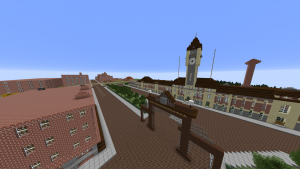As appearing in The Rocky Mountain Collegian
Playing video games is probably not most people’s first thought when the topic of a class project is brought up.
For his digital history course, Dr. Robert Jordan is having his students re-create Denver in Minecraft. Minecraft is a video game that gained popularity in the last few years due to its open-world system that allows players to build and craft to their heart’s content.
“I love video games, certainly,” Jordan said. “For me, those kind of virtual spaces are places of very powerful immersive learning.”
Jordan, who is in his fourth year as a professor of history at Colorado State University, said that the idea came to him after he saw a professor at a conference who had had her students re-create the Chicago World’s Fair in Minecraft. He said he felt that video games allow players to step outside themselves, and to experience life in very different ways.
For the project itself, which began last spring, Jordan and his students decided on 1905 as the era of Denver they would re-create. Jordan said that they wanted sometime far enough in the past that the city looked different, but a time that there were still enough records to work with. Students then used maps and other resources from the Denver Public Library to build the city on a Minecraft map which Jordan had created to match the topography and climate of the city.

“You end up using sanborn maps and historic photographs to help get an idea of what (Denver) looks like,” said Sami Slenker, a senior international studies major. “A lot of it is vetting historical documents to really verify and back up the construction.”
Slenker, along with several others, spent her free time this summer working on the map. Natalie Pace, a sophomore history and english major who also worked on the project, said that although the process can be tiresome, the work pays off when seeing the final product.
As of this fall, a large majority of Lower Downtown is complete with buildings and Jordan says that the hope is to have LoDo completely finished with informational signs and details by 2020. The final product will hopefully offer a faithful re-creation of 1905 Denver, and also offer information within the game that lets people use the map file as a way to learn history in an interactive way. The hope is that someday students can freely download the file, and then load it and use it to learn about many aspects of the history of Colorado’s capitol.
“It’s a slow process to really get it flushed out,” Jordan said. “The concern is whether or not people will still be interested in Minecraft in five years.”
So far, Jordan and his students have received overwhelmingly positive feedback about the project.
“It’s one of those things that no one has really done before,” said Patrick McCoy, a CSU grad who spent the summer helping Jordan with the project. “It’s so far out of the realm of what the average person believes they can do that when we say we’re doing it, everyone is interested.”
For anyone interested in getting involved in the project, the digital history class (HIST475) is offered during the spring semester. Jordan also said that there will be a formal presentation at the Denver Public Library over the project sometime in early November of this year. Anyone interested in learning more can keep an eye on Jordan’s website for updates.
For professor Robert Jordan, digital media is a way to present history to people in new and interesting ways.
“History is the story of life,” Jordan said. “If you like anything, there’s a historical facet of that to explore.”
Collegian Reporter Chapman W. Croskell can be reached at entertainment@collegian.com and on Twitter @Nescwick.
